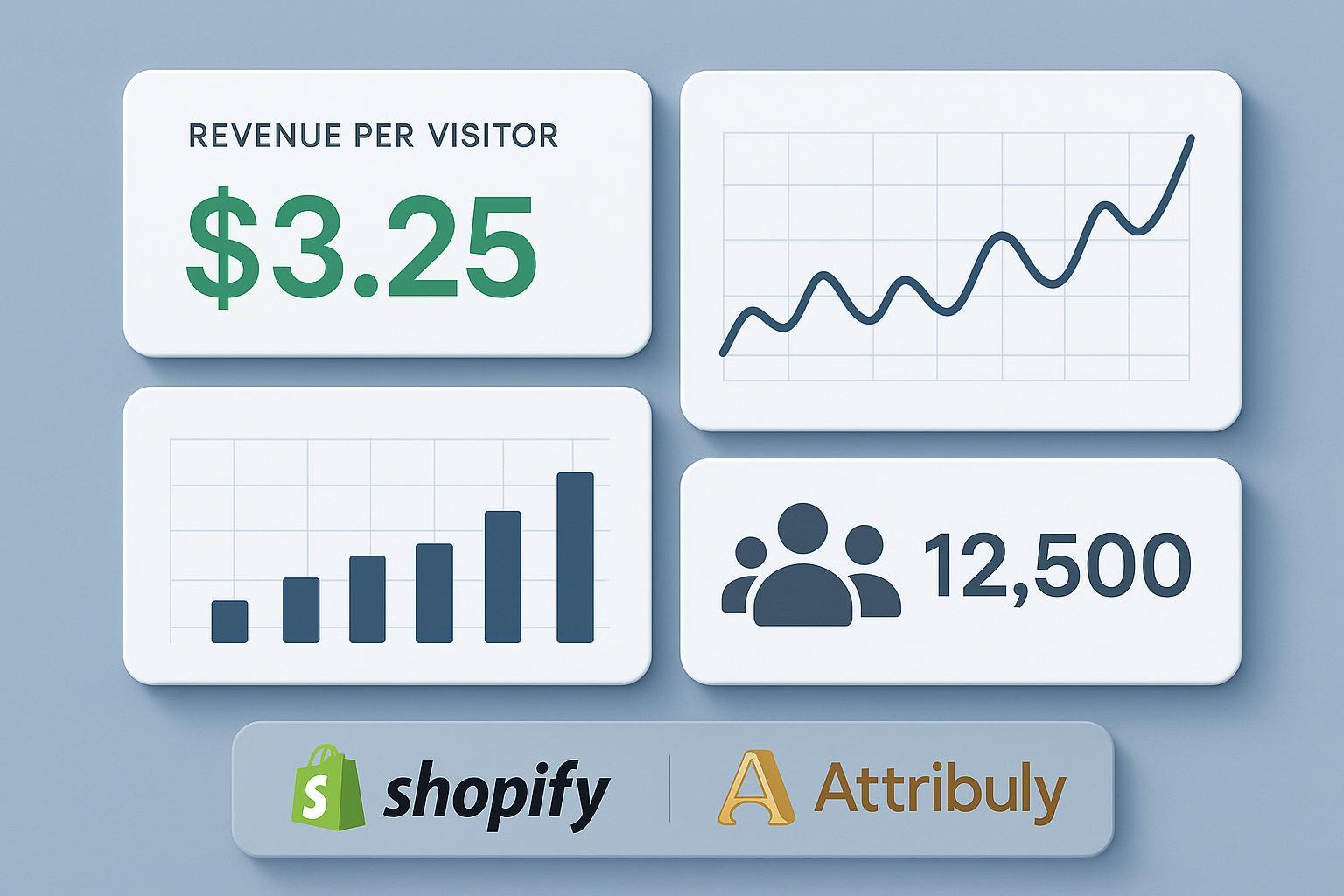Revenue Per Visitor (RPV): The E-Commerce Metric Every Shopify Brand Should Master

What Is Revenue Per Visitor (RPV)?
Revenue Per Visitor (RPV) is the average amount of revenue generated from each unique visitor to your online store. It’s one of the most actionable metrics for any e-commerce brand—especially those selling on platforms like Shopify—because it condenses the direct impact of both your conversion rate and your average order value into a single, easy-to-track measurement.
In simple terms: If you had 10,000 unique store visitors in August and generated $50,000 in revenue, your RPV for the month is $5. It answers the question, "How much is every person who lands on my store actually worth to my business?"
The RPV Formula: Two Approaches That Always Match Numbers
There are two main ways to calculate RPV, both yielding the same result:
-
Raw Calculation:
RPV = Total Revenue ÷ Number of Unique Visitors
-
Component Breakdown:
RPV = Conversion Rate × Average Order Value
Shopify Example Calculation:
- Unique visitors: 10,000
- Orders: 300
- Revenue: $50,000
- Average order value (AOV): $166.67 ($50,000 ÷ 300)
- Conversion rate (CR): 3% (300 ÷ 10,000)
- RPV: $5 ($50,000 ÷ 10,000)
- Or,
RPV = 3% × $166.67 = $5
This clearly shows that even a small lift in either CR or AOV will drive your RPV—and overall revenue—up.
Why RPV Matters in E-Commerce (And Why Most Merchants Undervalue It)
For e-commerce founders, Shopify merchants, and DTC marketers, RPV bridges the gap between traffic quality and store profitability. Where conversion rate tells you how well you turn visitors into buyers and AOV measures the average spend per order, RPV combines both to reveal the actual dollar value of every visitor.
- Optimize traffic spend: RPV helps determine how much you can afford to pay (CAC, ad budget) for each new visitor while remaining profitable.
- Strategy lens: It aligns with lifecycle metrics like CLV (Customer Lifetime Value) and ROAS (Return on Ad Spend), forming the backbone for growth strategies, channel allocation, and campaign measurement.
- Benchmarking: Industry data shows top DTC brands often maintain RPV between $4-$10, but the real value lies in segment-level analysis—by traffic source, campaign, and customer cohort. Read more on RPV’s e-commerce impact.
RPV vs. Other E-Commerce Metrics: Boundaries & Relationships
| Metric | What It Measures | Formula | Use Case |
|---|---|---|---|
| RPV | Revenue per unique visitor | Revenue ÷ Unique Visitors | Evaluate traffic value + store efficiency |
| AOV | Avg. order value | Revenue ÷ Orders | Upsell/cross-sell optimization |
| CR | Conversion rate | Orders ÷ Visitors | Track store performance, funnel effectiveness |
| CLV | Lifetime profit per buyer | Σ Customer Revenue | Guide retention/ad spend decisions |
| ROAS | Revenue per ad dollar spent | Revenue ÷ Ad Spend | Assess marketing efficiency |
- RPV is not the same as AOV or CR:
- AOV only reflects the order value but not how efficiently you convert traffic.
- CR only measures store performance, ignoring how much buyers spend.
- RPV puts them together, providing a holistic view of store health and acquisition efficiency.
How to Track and Optimize RPV: From Shopify to Attribuly
Tracking RPV
Shopify
- Default Analytics: Shopify tracks orders, sessions, and AOV, but not RPV directly.
- Manual Calculation: Export revenue and visitor data, then run the formula above. Segmentation (e.g., by channel or campaign) can be challenging.
Google Analytics 4 (GA4)
- Create custom reports or use Explorations for channel-based segmentation.
- Event-based tracking gives granular session, cohort, and revenue breakdowns, but setup can be complex for non-technical teams.
Attribuly: The Advanced Route
Attribuly takes RPV tracking and optimization to the next level, especially for fast-growing Shopify and DTC brands:
- Plug-and-play integration with Shopify, Google Analytics, Meta/TikTok/Bing Ads, Klaviyo, and more.
- Unified visitor + revenue data: Aggregates all customer journeys, across all marketing channels, into one real-time dashboard.
- Automated RPV calculation and segmentation: Instantly see RPV by channel, campaign, cohort, device—even geo-location and audience status (new vs returning).
- Multi-touch attribution: No more last-click guesswork—understand every touchpoint leading to revenue uplift.
- Server-side tracking: Accurately captures conversions while maintaining privacy compliance (critical in 2025).
- AI-powered optimization: Automated insights, smart segmentation, and campaign triggers to lift conversion rate, AOV, and RPV.
Scenario: A fashion DTC brand uses Attribuly to identify high-value visitors and launches segmented, multi-channel offers triggered when RPV rises/falls for key visitor groups. This lets them increase RPV by targeting those segments with higher-intent campaigns automatically.
See detailed Shopify analytics tool comparisons.
Practitioner Playbook: Boosting RPV Step-by-Step
- Optimize for Conversion Rate:
- Audit funnel (site speed, mobile UX, checkout friction)
- Deploy A/B test campaigns (see Shoplift AB Testing)
- Lift AOV:
- Use product bundling, upsell/cross-sell widgets, targeted promo codes
- Personalize recommendations based on segment history
- Segment and Personalize:
- Leverage Attribuly’s audience and behavioral data to sync high-value segments to Klaviyo or ad audiences.
- Trigger retargeting flows when specific visitors show a high RPV potential.
- Track and Benchmark:
- Compare your RPV against industry standards for your vertical; monitor trends by channel, campaign, and customer cohort
- Automate Optimization:
- Use Attribuly’s AI analytics assistant for weekly actionable reports: review segment-level uplifts, automate campaign triggers for underperforming segments, and sync insights to your marketing stack.
Top Tip: Even a fractional improvement—say, from a CRO test doubling mobile conversion rate—can move your RPV (and profit) by 10-20% in a single campaign cycle.
Downloadable Resources & Next Steps
For merchants serious about boosting RPV, driving smarter attribution, and tying every traffic investment directly to revenue, consider a free trial or demo at Attribuly. See instantly where your revenue is coming from, what segments to optimize next, and how to lift your RPV with automation, deep segmentation, and full-funnel analytics.
Final Thought: Why RPV Is the E-Commerce Growth Lever for 2025
Shopify and DTC brands face a margin-constrained world where every visitor counts. RPV gives you the clearest possible lens on traffic value—a number you can actually increase, not just observe. With next-generation platforms like Attribuly, measuring, segmenting, and optimizing RPV isn’t just possible—it’s actionable, scalable, and proven to drive revenue and ROI.
Ready to make every visitor count? Start optimizing your RPV today with Attribuly.
